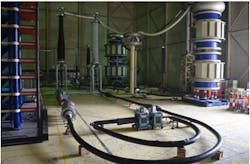G&W Electric’s EHV Cable Accessories Achieve 500 kV
G&W Electric recently introduced a new 500kV cable system for its complete series of Python EHV Cable Accessories. This latest cable system has passed the qualifying type test at the China Electric Power Research Institute. G&W’s Python EHV Cable Accessories are leveraged for solid dielectric insulated high voltage cable, and the 500kV cable system now includes PAT190, SSC190, PMJ190-N, PMJ190-B and 2500 mm2 XLPE Cable.
Efforts to ensure that the Python family of products met the highest voltage standards began in 2011. In 2015, the complete series of products passed the type test for 330kV, meeting both IEC and AEIC requirements. Earlier in 2018, the electrical part of the type test for 500kV passed in the first attempt, a rare achievement for such a critical test. The success of this test is largely due to the accessory’s new design and enhanced technology, where key components of the silicon rubber are under dry conditions. Upon completion of this type test, an enhanced level impulse was added to the cable loop and the product passed an impulse at one class higher.
“Innovation into higher voltage classes has been the cornerstone of G&W Cable Accessory development throughout our 113 years in business,” said John Mueller, Chairman and Owner of G&W Electric. “Knowing limited companies have achieved this voltage level in testing, we are proud of our ongoing ability to provide state-of-the-art options for our customers. We also commend the partnership between our engineering teams in Bolingbrook and Shanghai to make this achievement possible.”
G&W overcame multiple challenges in the development of this system in order to achieve the highest rating possible. For instance, size and weight were large factors in creating the optimal solution such as trying to maintain the appropriate loop size needed while balancing the weight of the porcelain insulator, joint body and stress cone.
In overcoming the challenges of creating this new technology, this cable system is helping to facilitate positive environmental and local community changes. This includes improved efficiency in power consumption, more environmental awareness towards city landscapes (no overhead transmission) and less contamination from power equipment (oil free). A popular application of solid dielectric EHV cable is also in hydropower generation including pumped storage.
